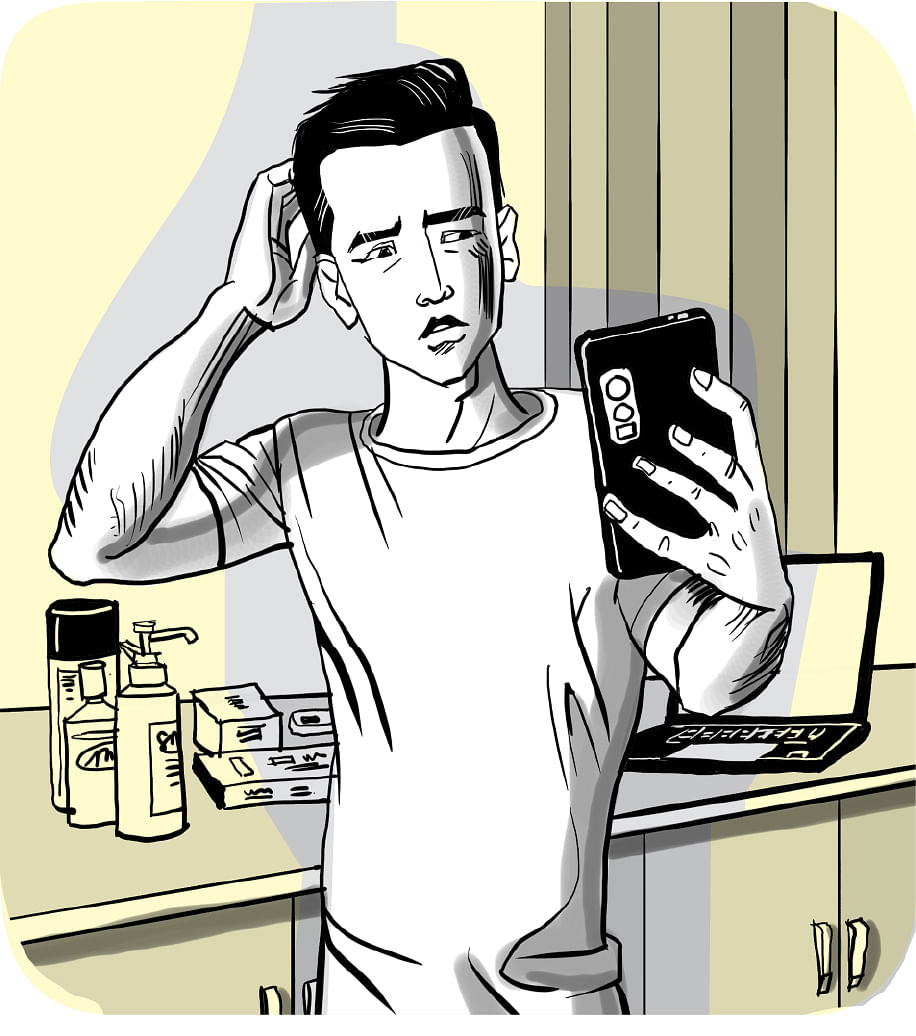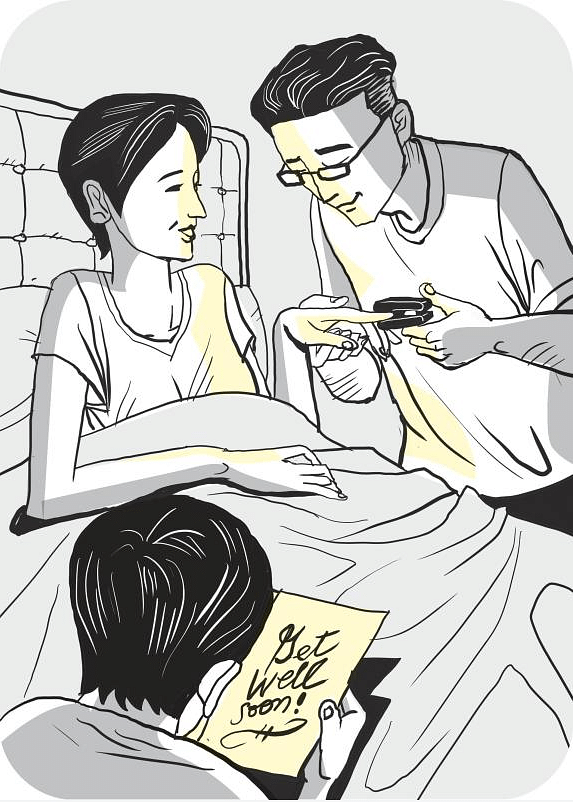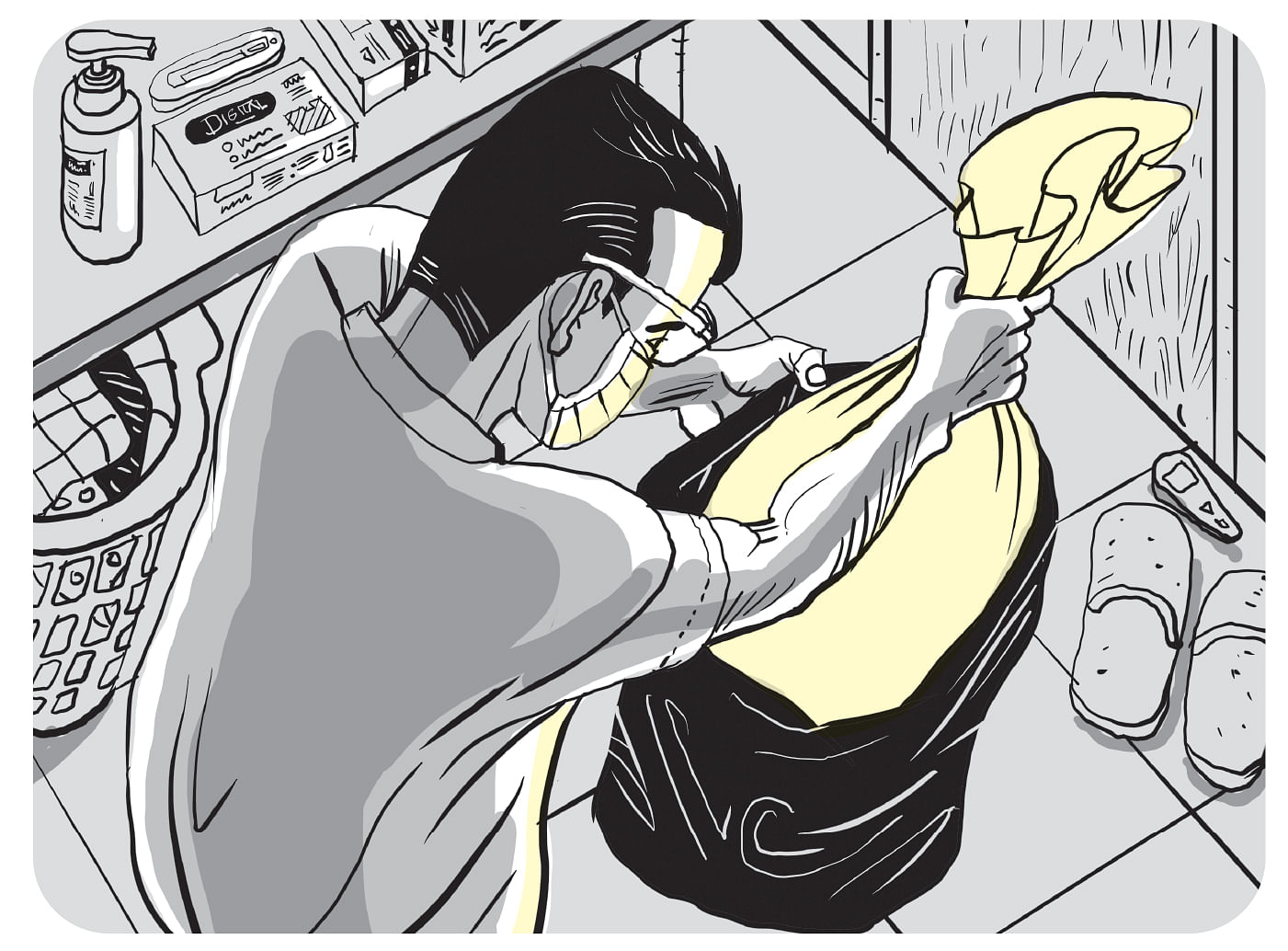At home with Covid-19: My 10 days of recovering from the virus
8 HOURS AGOLINETTE LAI AND TAY HONG YI
On Aug 30, Singapore's Ministry of Health (MOH) rolled out a month-long pilot programme which saw around 50 Covid-19 patients with mild symptoms recovering at home instead of a hospital or community care facility.
But less than two weeks into the trial, as case numbers began to increase exponentially, Health Minister Ong Ye Kung announced that home recovery would be the default for healthy, vaccinated individuals who were not living with other vulnerable people.
“This is very important so that hospital beds are allocated to those who truly need medical attention,” he said then. “We would have wished for more time to expand the pilot before making a bigger move, but we have no time to do that.”
People recovering at home were supposed to be matched with buddies to help answer questions, and they were to receive care packs containing items such as surgical masks and sanitiser.
But MOH was subsequently inundated with calls from people who needed advice specific to their circumstances, but could not get it elsewhere. It left many frustrated and confused, with some saying they felt they had been left alone.
The Straits Times speaks to those who went through the process to learn first-hand how to prepare for 10 days of recovering at home.

No discharge memo
After testing positive on Sept 13, a 52-year-old contractor who wants to be known only as Terence received a call from an MOH officer to confirm his home address and household contacts.It was the only call he received from the ministry. For the next 10 days, he was not sure if he was on the home recovery programme.
Terence, who lives alone in the Serangoon area, had erred on the side of caution, opting to take a polymerase chain reaction (PCR) test for Covid-19 infection despite not needing to.
“I was at Chinatown Complex on Sept 9 when the cluster emerged, and I received a health risk alert on Sept 12,” he said.
People who receive such alerts are not required to be tested but need to monitor their health for 14 days. They are also encouraged to perform self-tests throughout the 14-day period using ART self-test kits and reduce their social interactions.
“On the day I tested positive, the doctor from Raffles Hospital, where I was tested, called and informed me of my Covid-positive status.
“After that, an MOH officer called me to confirm my residential address and a link was sent via SMS to provide details of my household contacts for them to quarantine.”
To his knowledge, he fulfilled all the criteria to be placed on the home recovery programme, which is now the default for fully vaccinated people. But Terence said he never received any confirmation that he was on the programme.
“I received neither an SMS saying I was on the programme, nor any isolation order.”
Instead, Terence got a call at around 5pm on Sept 16 from someone who said she was from Certis, telling him he needed to be sent to a community care facility.
“She told me that transport would come to pick me up between 5pm and 11pm that day, if not the next day,” recounted Terence.
He was not told which facility and received no subsequent calls about the transport arrangements on Sept 16 and 17.
On Sept 18, he wanted to take an optional Day 6 PCR test, but received conflicting instructions on how to arrange it.
“I called MOH, and MOH said to call Certis, but Certis told me they could only act on MOH instructions.
“When I called MOH again, they told me to contact my (home recovery) buddy or telemedicine provider,” said Terence, adding that he was not told who his buddy or telemedicine provider was.
On Sept 22, the 10th day since he tested positive, he was not given instructions for an exit swab test or a discharge memo.
The TraceTogether app on his phone has since caused him much inconvenience, as his test status is “Not cleared” - accompanied by an exclamation mark on a red background.
Alarmed and unsure, food courts and construction worksites, where he works, erred on the side of caution and turned him away.
“They see red on my app and they ask me ‘What is that?’. After explaining, they ask me for a discharge memo, but there’s no discharge memo.”
According to MOH, no discharge memo is issued for home recovery patients who feel well and have finished 10 days of isolation.
“I’m going to lose my job, sooner or later. Companies (that engage me) will say ‘you can’t go there, you can’t go here, we have you around for what’.
“We all just want guidance on doing the right thing.”
Tips for the Covid-19 patient who lives alone
• Don’t be shy to ask your friends for help“Inform your friends to be on standby to get you anything you might need, and call them to pass it to you if needed.”
– Terence, in his 50s, works in the construction industry
• If you have limited antigen rapid test (ART) kits at home, you might want to save them for the later part of your home recovery stint
“I was told by my doctor that there is no point in taking an ART during the first few days, because there is a high likelihood I will still be positive. On the fifth day, when I took a test, it was positive. On the seventh day, it was negative.”
– Mr Lau, 40, a self-employed professional. He has been stuck at home since Sept 19 when he tested positive for Covid-19 after undergoing a PCR test.
READ MORE
Covid-19 patient recovering at home could not get clear instructions on what to do

Nothing like home
By K. TanMy son, who will turn 12 in January, caught Covid-19 on Sept 22.
It started with a cough, then a fever and concluded with a positive polymerase chain reaction (PCR) test.
As the person closest to him, I was also diagnosed on the same day.
After we tested positive, we quarantined ourselves in my room. But we were freed from the room shortly after, when, the next day, my husband also tested positive.
The happy part of this story was that, on Sept 15, about a week before we caught Covid-19, the home recovery programme kicked in.
When my son and I tested positive, we applied to stay home together. My husband did the same too when he got his results.
Initially, there was a bit of confusion over what to do because we were given scanty instructions, but we sorted things out ourselves by reading the Ministry of Health (MOH) website.
We then hunkered down for self-isolation at home.
The home recovery scheme is to lighten the load of medical personnel and facilities, but I am sure being at home also played a very big part in our recuperation.
For a few days after testing positive, we were knocked out by flu-like symptoms such as a fever, headache, runny nose and fatigue, and nothing beats the comfort of home when you are feeling this way.
Even just lying in a familiar bed made me feel better, which must have, in turn, helped me get well faster. You know, the mind-body connection and all that.
We are thankful that my husband and I met the criteria for home recovery: We are both vaccinated, do not have any health issues, had mild symptoms and do not have any elderly persons living with us.
Although our son was unvaccinated because he had not hit the age requirement, as a young person, he did not seem to be terribly affected by the virus.
Apart from regular bouts of coughing, he was easily the most sprightly person in the house.
So sprightly that I told him more than once I wished they had taken me away to a care facility so that I can rest quietly. (No, I'm kidding. They should take him.)
We religiously monitored our temperatures and blood oxygen saturation with the Temasek Foundation-issued oximeter, which checks the oxygen level in the blood and can help detect early signs of a deterioration in health.
It came in very handy - it gave us the peace of mind that we were doing all right.
We were not suffering from any life-threatening symptoms, so all we needed to get well were some doctor-prescribed paracetamol tablets, blankets, hot honey lemon drinks and Netflix.
Meals were a problem initially. On the first day that we were isolating at home, we ordered in lunch, but quickly discovered that outside food was terribly unappetising when you were sick.
The other hard-to-swallow bit was that food delivery is expensive. Multiply two meals a day by the 10 days of home isolation and a bout of Covid-19 could leave a sizeable deficit in our bank account.
In the end, we fell back on the love and kindness of family and friends, something which Grab cannot deliver.
My mother-in-law and mother quickly swooped in and took turns to cook our meals and get them dropped off at the doorstep of our apartment.
Along with the convalescent food, they also delivered plenty of fresh fruit, vegetables, fish and meat should we feel up to cooking simple meals.
Colleagues and friends too sent care packages, which shored up our inner fortitude to tide over this mini crisis.
Fortunately, we were not sick for too long. Within days, even the adults were up and about on our feet again (thank you, vaccine!).
Which was when we discovered the other advantage of recovering at home was that my workaholic husband could quickly get back to work, and, because the Primary 5 year-end exams be upon us, our son could attend home-based learning, which is crucial. (He disagrees.)
After 10 days of being at home which, thankfully, was without too much drama, we were automatically discharged. A PCR test is not required on the tenth day, and neither will there be a discharge memo.
The MOH website advises recovered patients to minimise social contact for another seven days afterwards, which we will be doing so.
Although I would not wish to catch Covid-19, being allowed to recover at home is one of the better things that can happen in a bad situation.
Tip for households with more than one case of Covid-19
• Regularly monitor your temperatures and blood oxygen saturation“We religiously monitored our temperatures and blood oxygen saturation with the Temasek Foundation-issued oximeter, which checks the oxygen level in the blood and can help detect early signs of a deterioration in health. It came in very handy - it gave us the peace of mind that we were doing all right.”
– Ms K. Tan, 40s, media executive
READ MORE
Like a thief in the night, Covid-19 broke into our home

Tough for some caregivers
Having family members at home can mean quick access to food and services. But it can be tough for the caregivers.When CK, who declined to have her name published, saw that her houseplants in the common corridor had been watered after she returned from a Covid-19 testing centre, she knew what it meant.
Her father, who had contracted the virus and was supposed to remain in his room, had broken the rules.
“I was very stressed... We had to keep highlighting how his behaviour is going to cause a lot of inconvenience for the rest of us before he started to self-isolate more often,” said the personal assistant in her 30s, who lives in a Housing Board flat with her parents and brother.
“He would walk around the house because he wanted to talk to my mum. Occasionally, he went out to water the plants or sit at the staircase.”
When CK’s father, who is in his 60s, tested positive on Sept 19 - a Sunday - his family thought he would be taken to a recovery facility as he has an underlying heart condition and had been hospitalised earlier this year because of it. His Covid-19 symptoms - which included a runny nose and fever - were relatively mild.
But although the family of four was served home quarantine orders from Sept 20, nobody contacted them about her father’s condition until Friday.
The caller, a telemedicine provider, said someone would drop by to check on her father over the weekend. Nobody did.
As CK’s father did not stick to using one set of utensils, the rest of the family washed all cups and plates with boiling water before using them.
They also wore masks at home and disinfected surfaces when he returned to his room after being in the common areas.
“He was very frustrated and didn’t have any official advice telling him what to do,” CK said. “To him, this is his home and these are his things. He didn’t understand why we were controlling him.”
The family also did not get a care pack, which is supposed to contain items such as a thermometer, hand sanitiser and surgical masks.
“I think these are the basic things you should have at home, as well as test kits and some disinfecting spray,” CK said. “Because you never know when you will need them, and MOH is really overwhelmed.”
The whole family - including CK’s father - is vaccinated, and did ART tests regularly while in quarantine. They tried to contact MOH several times, but were only able to reach phone operators who were not equipped to give advice on their specific situation.
When CK asked if her father could be taken to a recovery facility because they were finding it hard to keep him indoors, they suggested she call the police instead.
“If I had wanted my father to be caught, I would have called 999,” she said. “What if I had driven him crazy?”
“I felt that we were one of the families that had been forgotten,” she added. “Nobody checked on my dad or monitored his condition.”
Tip for those caring for a Covid-19 patient at home
• Wear masks at home and clean surfaces frequently if infected family members do not self-isolate“We wear masks every day. I also ordered disinfecting spray. Every time my dad accesses a different part of the flat, I will use it to keep everything as clean as possible after he returns to his bedroom.”
– CK, 30s, a personal assistant
READ MORE
askST: How to tell if you've been placed on the home recovery programme

Kept family safe
During his 10-day home recovery stint, Mr Toh Kian San developed a strict routine.Anything that left his room - from food waste to dirty clothes - was double-bagged before it was handed over to his wife and teenage children.
Wearing disposable gloves, they would help Mr Toh carry out his chores before stripping off the gloves and sanitising their hands.
“We also told our neighbours that I had tested positive,” the 53-year-old taxi driver said in Mandarin. “That way, they wouldn’t wonder why my family was suddenly avoiding them if we saw them at the central chute on our floor.”
Mr Toh had tested positive for the virus on Sept 17, and came down with a fever, sore throat and body aches.
After two days without hearing from anyone at MOH, he called the ministry and was asked if he would like to recuperate at home or be sent to a recovery facility.
Mr Toh chose to stay home, partly because his Pasir Ris apartment has two balconies. One is attached to the master bedroom, where he was isolating himself, and the other is connected to the living room.
The family of four would don masks when talking to each other from their separate balconies.
“At least I could see my children that way, even though we were a few metres apart,” he said.
They are all fully vaccinated and put on masks whenever they came into close contact with Mr Toh, such as when they had to leave meals outside his bedroom door.
Mr Toh took his temperature three times daily, and was contacted by a telemedicine provider on the fifth day. By that time, his symptoms had already begun to subside, he recalled.
“For me, it was like a normal flu. Just that it’s very transmissible, so that’s what made me a bit anxious.”
His main concern now is getting back to work. Although he has completed his home recovery stint - with MOH saying that people can be discharged after the 10-day period - his TraceTogether app still shows that he has not been cleared.
The taxi company he works for told him he cannot get back on the road.
“They waived the taxi rental, but of course my family is still impacted because I have no income,” he said. “My wife is working from home, so right now it’s one person supporting the four of us.”
Tips for the Covid-19 patient who is living with healthy people
• Double-bag your rubbish to protect your family“I put my food waste or dirty clothes into a plastic bag, and then I put the whole bag into another bag for my family to collect it.”
– Mr Toh Kian San, 53, taxi driver
• Take a self-test using an ART kit upon being informed of exposure to Covid-19
“A day before my PCR test, I tested positive on the ART, when my symptoms were still very light. This gave my family time to exchange my room and prepare for home recovery.”
– Ms Isabella Ng, 26, a training officer. She tested positive on Sept 17, after home recovery became the default care model for vaccinated Covid-19 patients on Sept 15.

